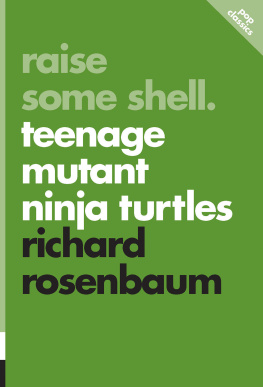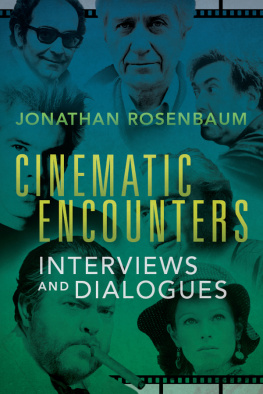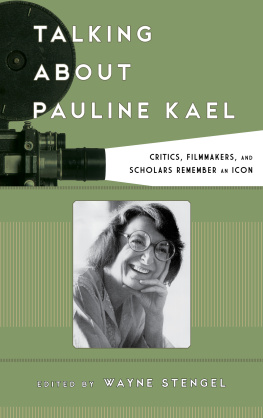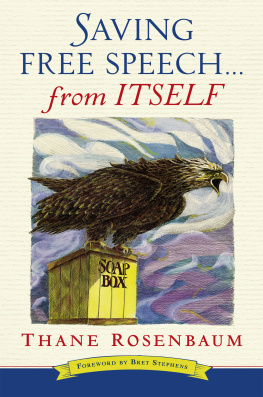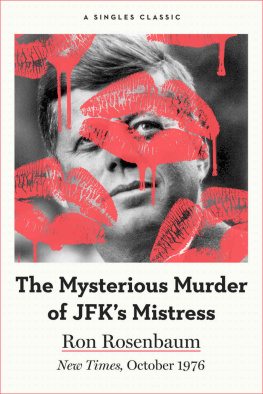The University of Illinois Press
is a founding member of the
Association of University Presses.
_______________________
University of Illinois Press
1325 South Oak Street
Champaign, IL 61820-6903
www.press.uillinois.edu
JONATHAN ROSENBAUM was the film critic for the Chicago Reader from 1987 to 2008. He is the coauthor of Abbas Kiarostami, Expanded Second Edition and the author of Cinematic Encounters: Interviews and Dialogues and Goodbye Cinema, Hello Cinephilia. He archives his work at jonathanrosenbaum.net.
CHAPTER 1
Chantal Akerman
As with Sylvia Plath, Chantal Akerman's critical stock seemed to shoot up as a direct consequence of her suicide, giving far too much ill-considered value, in my opinion, to both her bipolarity and her final film, No Home Movie (2015). By neglecting her fiction films, this essay, commissioned by Icarus Films for their DVD box set Chantal Akerman: Four Films in 2016, can't pretend to encompass the full range of her workher status as a Belgian surrealist, for example, which links her to another filmmaker considered in this book, Andr Delvaux, is overlookedbut I hope it can provide a useful starting point. An even longer and more comprehensive survey of Akerman's work, though it only goes up to 2004, can be found at https://www.jonathanrosenbaum.net/2012/02/chantal-akerman-the-integrity-of-exile-and-the-everyday-tk/.
Place and Displacement: Akerman and Documentary
When you try to show reality in cinema, most of the time it's totally false. But when you show what's going on in people's minds, that's very cinematic.
Chantal Akerman
If I had to describe the art of Chantal Akerman (19502015) in a single word, I think I'd opt for composition. This is a term that needs to be understood in its plastic as well as its musical meanings: a visual object that has to be framed in space, a musical object that has to be composed in time. And if we factor in the implied definitions offered above by Akerman regarding what's reality and what's cinematic, what's going on in people's minds and what's going on in front of a camera and microphone, then we have to acknowledge that what she chooses to compose represents a kind of uneasy truce between all four elements (or five elements, if we regard sound and image as separate). How much she and we privilege mind over matter and cinema over realityor vice versahas a lot of bearing on what's derived from the encounter.
The four Akerman documentaries included in this box setD'est (From the East, 1993), Sud (South, 1999), De l'autre ct (From the Other Side, 2002), and L-bas (Down There, 2006)and the documentary about her included as an extra (Gustavo Beck and Leonardo Luiz Ferreira's 2010 Chantal Akerman, From Here) are all self-described in relation to place. Yet all five films are deeply involved with displacement, thanks to the uneasy truces between their elements that I've just alluded to. Chantal Akerman, From Here is further displaced from the four Akerman films by virtue of the fact that it may appear superficially to resemble her own films in its handling of space and time, although I would argue that in fact it does something that's actually antithetical to her methodology: a fixed camera position that seems uncomposed, at least in relation to Akerman's own monumentally forceful and weighted framings, and a use of real time that seems similarly haphazard and unfocused in contrast to the more structured uses of real time that she periodically employs. As Akerman herself points out in the interview proper, which gives Chantal Akerman, From Here its undeniable value and relevancy, the household rituals of Jeanne Dielman in her most famous fiction film, even if they seem to unfold in real time, are in fact recomposed. And even more relevant are her remarks in this interview about the viewer's perception of time passing, as opposed to the more commercial norm of time flying bya subjective experience that is far removed from the notion of real time adopted by Beck and Ferreira. (If I have a reputation for being difficult, she once said, it's because I love the everyday and want to present it. In general people go to the movies precisely to escape the everyday.) This helps to explain why, in the same interview, she notes that documentaries gave her more freedom as an editor than her narrative features by virtue of allowing her more choices in how to combine disparate materials. Freed from the tyranny imposed by the necessity of following stories and characters, her best documentaries can arguably call on a fuller range of both her aesthetic resources and the imaginations of her viewers, which is implied by the title she gave to her 1995 installation related to From the East, Bordering on Fiction.
A brilliant French television producer once showed me a paper he wrote arguing that Akerman's greatest films were her documentaries, and he asked me for comments. My main comment was to ask about the 201-minute Jeanne Dielman, 23 Quai de Commerce, 1080 Bruxelles (1975), only to discover that he'd never seen it. But despite this major caveathis overlooking of one of Akerman's greatest films, with an indelible depiction of housework and other forms of female entrapment, a subject that becomes no less worthy of epic proportions than those of From the East and From the Other SideI think his overall point has some merit. It's especially valid once one acknowledges that like many of the other greatest filmmakers, Akerman worked in a zone in which nonfiction and fiction frequently intermingle and sometimes even trade places. The final sequence of From the Other Side is arguably more novelistic in the depth of its feeling and in its creation of a fictional temporality than anything in her no less distinctive adaptation of Marcel Proust, La captive (2000), while the final sequence in her only other (and no less free) adaptation of a novel, Joseph Conrad's Almayer's Folly (2011), ends with a striking use of extended real time that becomes in effect a documentary about its lead actor, Stanislaus Merhar. Furthermore, it is easy to conclude that Les annes 80 (1983), her documentary about the making of her only musical, Golden Eighties (1986), is far more successful and expressive, even as a musical, than the finished work (largely because of Akerman's own contributions during the recording sessions)a bittersweet tale of crossed romantic destinies that unfolds almost entirely inside a shopping mall.
Returning to Akerman's statement about what's cinematic, I think it's fair to say that From the East, South, From the Other Side, and Down There are only nominally and incidentally films about a journey from Berlin to Moscow, or the town of Jasper, Texas, or the border between the United States and Mexico, or a narrow patch in Tel Aviv mainly consisting of a room in Akerman's rented flat and its immediate environs. More basically, they're films about the states of Akerman's consciousness, her thoughts and feelings of displacement and alienation in relation to those places. Such displacements can be found throughout her workperhaps most memorably in two films linking her sense of homelessness with the figure of her mother: News From Home (1976), occasioning what was perhaps her first major use of autobiographical and documentary materials (letters from her mother that are read by Chantal over shots of New York), and No Home Movie (2015), her final film (mostly conversations with her mother, shortly before her mother's death, during which she tries and fails to get her to open up about other family membersconversations that, as Janet Bergstrom has written, are filled with the tension of Akerman's need to interrogate her mother about things that were taboo for her since childhood).
Next page





